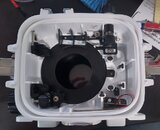This is a face-sealing o-ring, there is no need to grease it. The grease facilitates the o-ring sliding in its groove; it does not contribute to sealing. When you close the housing, this o-ring gets squeezed between the front and back parts, but there is no sliding involved, so it does not need greasing. Wash it, dry it, press it into the groove and pretty much leave it alone.
There is a second o-ring on the back side of the housing -
that one does slide, as it seals against the outer edges of the front side. Pull it out, give it a
light coating of grease and put it back on - it stretches over the groove, so it isn't going anywhere.
Unless you're diving in very silty conditions, there is no need to mess around with o-rings between dives - just use something lint-free to wipe away water droplets when you open the housing. I generally clean and grease the o-rings once a trip and don't touch them otherwise unless the vacuum system alerts me something is wrong.
Speaking of vacuum systems, if you've bought the VPS-100 with your housing, SeaFrogs' instructions for its use are quite clear: "WARNING - THIS ACCESSORY IS NOT MEANT TO BE USED UNDERWATER AS PER MANUFACTURER INSTRUCTIONS! ANY ATTEMPT TO DO SO CAN CAUSE EQUIPMENT LOSS AND IS NOT COVERED BY THE WARRANTY!"
And indeed there is a reason for this warning - the protective cap that covers the top of VPS-100 is not 100% waterproof. Over the course of 250 or so dives on which I used my SeaFrogs housing with the VPS-100 attached, I have had two instances where this cap leaked, filling the valve with water (which destroyed the valve electronics) and admitting small amounts (several drops) of water into the housing - not enough to kill the camera, but not a good experience nonetheless.
On the other hand, following SeaFrogs' instructions to 'Remove the valve from the backplate and place the vacuum opening lid in its original place, make sure the O-ring is still there (Illustration 1). - safe to dive!' does not strike me as an optimal solution either - for one thing, there is nothing that tests the integrity of the vacuum port cap seal itself, which makes it a potential water ingress point; for another, having the housing under vacuum pre-loads the o-rings, reducing the chance of leakage on the surface or if the housing is bumped in the rinse tank, and releasing the vacuum removes this advantage.
However, as it turns out, there is an alternative - Vivid Housings makes a version of their Leak Sentinel V5 XB that is compatible with SeaFrogs housings. It is not listed for sale anywhere that I could find, but if you contact Miso Milivojevic directly at
info@vividhousings.com, he will sell one directly for €230 including free worldwide shipping by registered mail, although this does not include a pump - manual pump is an extra €25 while an electric pump is another €50. I have just taken delivery of mine and can confirm that it fits and it works.
I'm not affiliated with either SeaFrogs or Vivid Housings in any way, but as an avid user, I can wholeheartedly recommend this solution.





